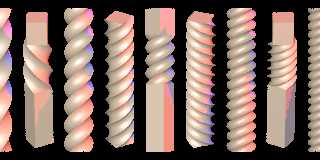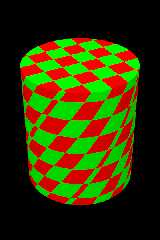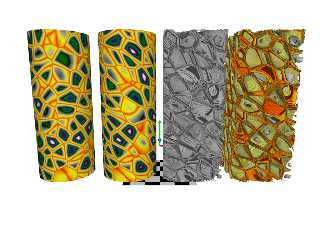 |
 |
|
 |
|
 |
|  |
|  |
|
 |
|
 |
|  |
|  |
|
 |
So, I was trying to puzzle out how to texture the rotated and twisted pigment
function isosurfaces I've been working on, and it became clear that there's no
way to continually rotate a pigment pattern around an axis as a function of that
abscissa.
To my knowledge there is currently no way to do this to a pigment.
Attached is a simple illustration of a cylinder textured with such a warped
pigment (hexagon).
This was done by taking intersections of the cylinder and thin discs, that were
textured with a progressively rotated version of the pigment and stacked.
Post a reply to this message
Attachments:
Download 'pigment{} rotation warp.png' (130 KB)
Preview of image 'pigment{} rotation warp.png'

|
 |
|  |
|  |
|
 |
|
 |
|  |
|  |
|
 |
Le 15/07/2019 à 04:16, Bald Eagle a écrit :
>
> So, I was trying to puzzle out how to texture the rotated and twisted pigment
> function isosurfaces I've been working on, and it became clear that there's no
> way to continually rotate a pigment pattern around an axis as a function of that
> abscissa.
>
> To my knowledge there is currently no way to do this to a pigment.
>
> Attached is a simple illustration of a cylinder textured with such a warped
> pigment (hexagon).
>
> This was done by taking intersections of the cylinder and thin discs, that were
> textured with a progressively rotated version of the pigment and stacked.
>
Looks a lot like attached picture, but for texture instead of shape.
Is there a need for deep control or can a simpler version be enough ?
1. can origin of the axis always be <0,0,0> ?
Or should it be customisable ?
2. can the direction of the axis be specified ?
Or should it always something like +z ?
3. can the handedness of the rotation be always the same ?
Or should it be customisable ?
4. can the distance between two complete rotations be always the same ?
Or should it be customisable ?
5. should the rotation always occurs ?
Or should it occurs only for a bounded range along the axis ?
6. should the rotation be of constant speed along the axis ?
Or should it use something like *dist_exp* from
http://wiki.povray.org/content/Reference:Warp#Mapping_using_warps
with something else than 1 as its value ?
Post a reply to this message
Attachments:
Download 'leforgeronscrew.png' (108 KB)
Preview of image 'leforgeronscrew.png'

|
 |
|  |
|  |
|
 |
|
 |
|  |
|  |
|
 |
Le_Forgeron <jgr### [at] free fr> wrote:
> Is there a need for deep control or can a simpler version be enough ?
>
> 1. can origin of the axis always be <0,0,0> ?
> Or should it be customisable ?
I think for most things applying the warp and then a translate would be fine.
> 2. can the direction of the axis be specified ?
> Or should it always something like +z ?
Again, I think for most things applying the warp and then a rotate would be
fine.
> 3. can the handedness of the rotation be always the same ?
> Or should it be customisable ?
Why not just have a signed amount?
> 4. can the distance between two complete rotations be always the same ?
> Or should it be customisable ?
Indeed, I thought of this, and perhaps there's a whole new idea that may dwarf
even this small level of complexity. *
> 5. should the rotation always occurs ?
> Or should it occurs only for a bounded range along the axis ?
For now, I'd say keep it simple, unless the choice of a bounded is not much more
complicated.
> 6. should the rotation be of constant speed along the axis ?
> Or should it use something like *dist_exp* from
> http://wiki.povray.org/content/Reference:Warp#Mapping_using_warps
> with something else than 1 as its value ?
An excellent question, and one that almost hits on my thoughts on #4 (*)
Perhaps to allow added user-control, with user-defined functions, there can be a
warp_map, such that the affected regions and degree of effect of a warp can be
controlled by a spline.
warp {
rotate x linear // quadratic cubic bezier
warp_map {
[0.00 pi/2] // per POV unit
[0.50 2*pi]
[0.75 3*pi/2]
[0.00 pi/2]
}
}
This may be way too complicated, as there are a lot of moving parts under the
hood, and I don't know how much this would slow things down if applied. fr> wrote:
> Is there a need for deep control or can a simpler version be enough ?
>
> 1. can origin of the axis always be <0,0,0> ?
> Or should it be customisable ?
I think for most things applying the warp and then a translate would be fine.
> 2. can the direction of the axis be specified ?
> Or should it always something like +z ?
Again, I think for most things applying the warp and then a rotate would be
fine.
> 3. can the handedness of the rotation be always the same ?
> Or should it be customisable ?
Why not just have a signed amount?
> 4. can the distance between two complete rotations be always the same ?
> Or should it be customisable ?
Indeed, I thought of this, and perhaps there's a whole new idea that may dwarf
even this small level of complexity. *
> 5. should the rotation always occurs ?
> Or should it occurs only for a bounded range along the axis ?
For now, I'd say keep it simple, unless the choice of a bounded is not much more
complicated.
> 6. should the rotation be of constant speed along the axis ?
> Or should it use something like *dist_exp* from
> http://wiki.povray.org/content/Reference:Warp#Mapping_using_warps
> with something else than 1 as its value ?
An excellent question, and one that almost hits on my thoughts on #4 (*)
Perhaps to allow added user-control, with user-defined functions, there can be a
warp_map, such that the affected regions and degree of effect of a warp can be
controlled by a spline.
warp {
rotate x linear // quadratic cubic bezier
warp_map {
[0.00 pi/2] // per POV unit
[0.50 2*pi]
[0.75 3*pi/2]
[0.00 pi/2]
}
}
This may be way too complicated, as there are a lot of moving parts under the
hood, and I don't know how much this would slow things down if applied.
Post a reply to this message
|
 |
|  |
|  |
|
 |
|
 |
|  |
|  |
|
 |
Jerome,
Are you considering experimenting with this warp idea in HgPovRay?
I'd like to install that, but I need some detailed installation instructions -
I've only recently made the full switch-over from M$ to Linux Mint.
Is there a way, at some point, to set that up to be installed with apt-get?
or the Mint "Software Manager"? (mintinstall)
Thanks
Post a reply to this message
|
 |
|  |
|  |
|
 |
|
 |
|  |
|  |
|
 |
Le 15/07/2019 à 22:09, Bald Eagle a écrit :
> Jerome,
>
> Are you considering experimenting with this warp idea in HgPovRay?
Maybe, but do not hold your breath on it.
>
> I'd like to install that, but I need some detailed installation instructions -
> I've only recently made the full switch-over from M$ to Linux Mint.
It's the same way as for installing povray from sources (so, not from a
package)
1. get the sources (zip or tar.gz)
2. extract them somewhere
3. run in the extracted directory: ./unix/prebuild.sh
4. run: ./configure COMPILED_BY="Bald Eagle"
5. if configure is happy (no missing packages), run: make
6. run: make check
7. either copy unix/povray in /usr/local/bin/hgpovray,
or run: sudo make install (it overwrites povray !)
you can get sources at https://github.com/LeForgeron/povray/releases
Steps 1 & 2 can be replaced by cloning the git repository, but that's
not for innocent users.
>
> Is there a way, at some point, to set that up to be installed with apt-get?
> or the Mint "Software Manager"? (mintinstall)
>
That's a long long long road, I'm not sure to engage.
I would need to set up a ppa:, and add files for the debian generation...
And states if it excludes official povray or can cohabit with it.
> Thanks
>
Post a reply to this message
|
 |
|  |
|  |
|
 |
|
 |
|  |
|  |
|
 |
Le 15/07/2019 à 04:16, Bald Eagle a écrit :
>
> So, I was trying to puzzle out how to texture the rotated and twisted pigment
> function isosurfaces I've been working on, and it became clear that there's no
> way to continually rotate a pigment pattern around an axis as a function of that
> abscissa.
>
> To my knowledge there is currently no way to do this to a pigment.
>
> Attached is a simple illustration of a cylinder textured with such a warped
> pigment (hexagon).
>
> This was done by taking intersections of the cylinder and thin discs, that were
> textured with a progressively rotated version of the pigment and stacked.
>
Patch done in Hgpovray38
( available at
https://github.com/LeForgeron/povray/releases/tag/v3.8.0.alpha%2BHg.227.Bl%C3%A9
> https://github.com/LeForgeron/povray/releases/tag/v3.8.0.alpha%2BHg.227.Bl%C3%A9
Post a reply to this message
Attachments:
Download 'wr.png' (38 KB)
Preview of image 'wr.png'

|
 |
|  |
|  |
|
 |
|
 |
|  |
|  |
|
 |
Le_Forgeron <jgr### [at] free fr> wrote:
> Patch done in Hgpovray38
> ( available at
> https://github.com/LeForgeron/povray/releases/tag/v3.8.0.alpha%2BHg.227.Bl%C3%A9
LOL. Somehow I knew you just couldn't resist. :D
I just got done coding a version in SDL last night, which is part of why I was
trying to get the pigment-mapped pattern in color.
I'll try to get Hg installed soon so I can look it over and play.
Nice work :) fr> wrote:
> Patch done in Hgpovray38
> ( available at
> https://github.com/LeForgeron/povray/releases/tag/v3.8.0.alpha%2BHg.227.Bl%C3%A9
LOL. Somehow I knew you just couldn't resist. :D
I just got done coding a version in SDL last night, which is part of why I was
trying to get the pigment-mapped pattern in color.
I'll try to get Hg installed soon so I can look it over and play.
Nice work :)
Post a reply to this message
|
 |
|  |
|  |
|
 |
|
 |
|  |
|  |
|
 |
The twisted pigment makes a fun isosurface, that would fit into some sort of art
gallery scene or corporate sculpture.. ;)
Post a reply to this message
|
 |
|  |
|  |
|
 |
|
 |
|  |
|  |
|
 |
Crackle gives something that would make a fine concretion of seashells or other
conglomerate.
Post a reply to this message
Attachments:
Download 'documentationfigures.png' (327 KB)
Preview of image 'documentationfigures.png'

|
 |
|  |
|  |
|
 |
|
 |
|  |
|  |
|
 |
On 17-7-2019 23:21, Bald Eagle wrote:
> Crackle gives something that would make a fine concretion of seashells or other
> conglomerate.
>
Yes! That is a nice one!
--
Thomas
Post a reply to this message
|
 |
|  |
|  |
|
 |
|
 |
|  |




![]()